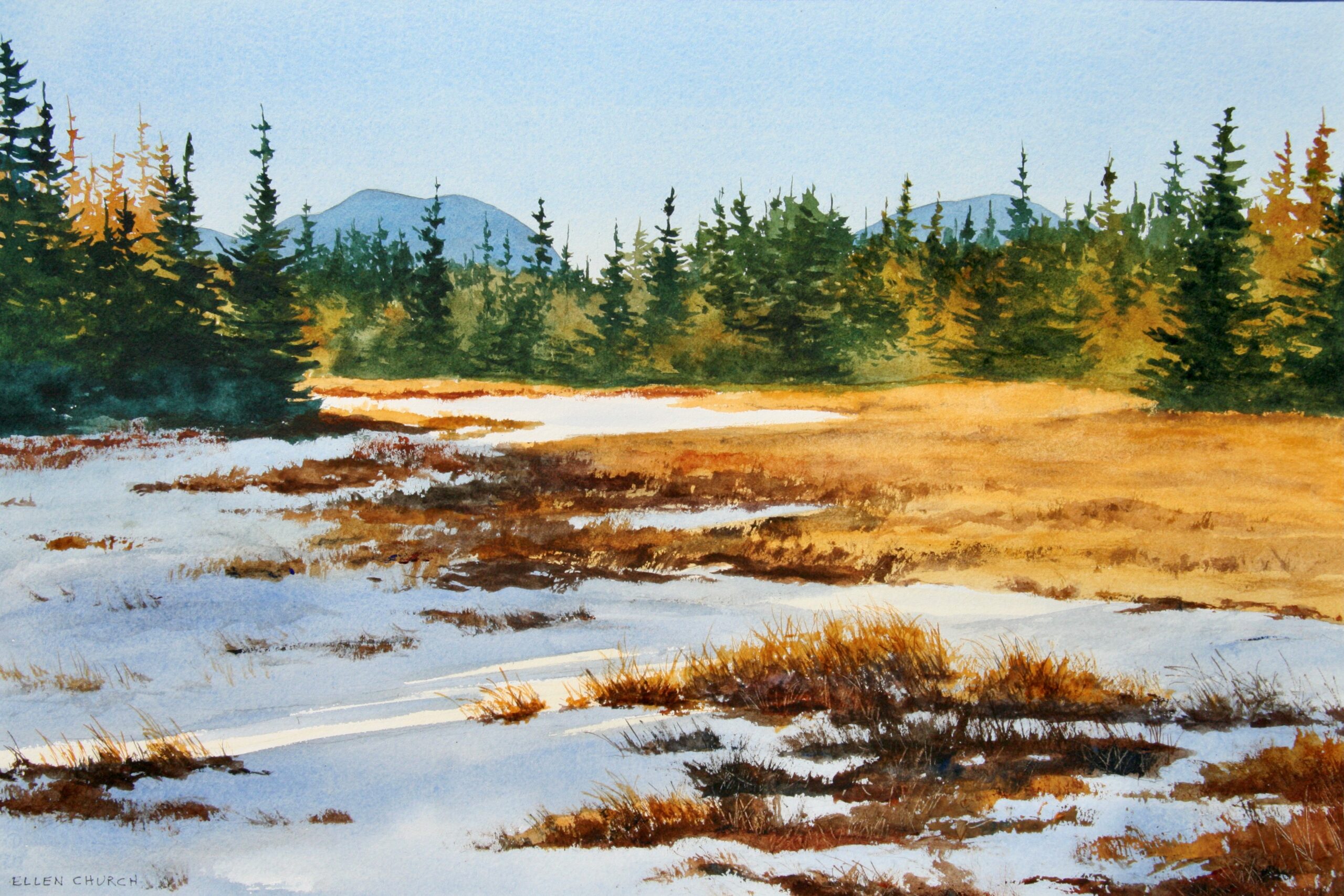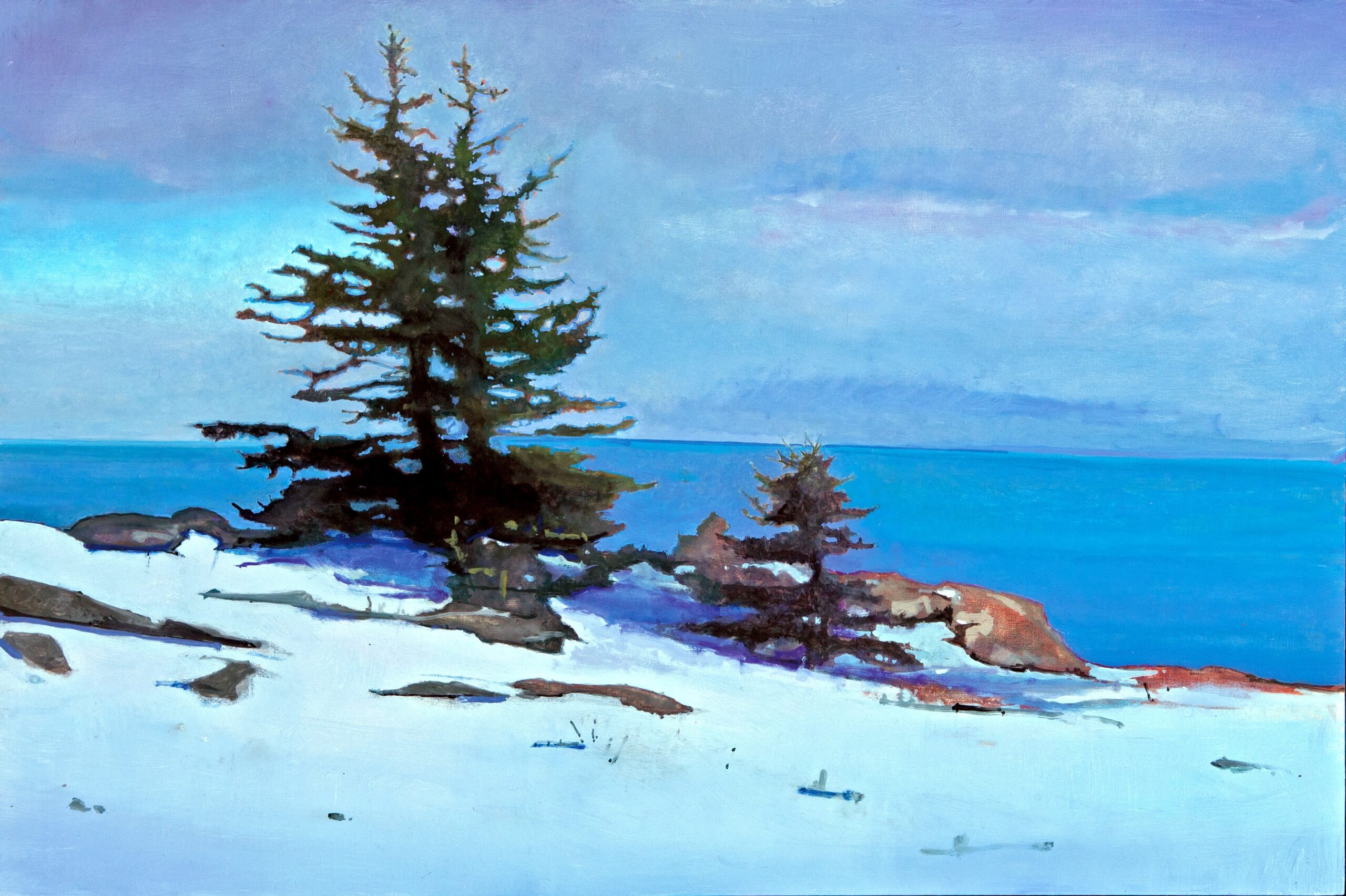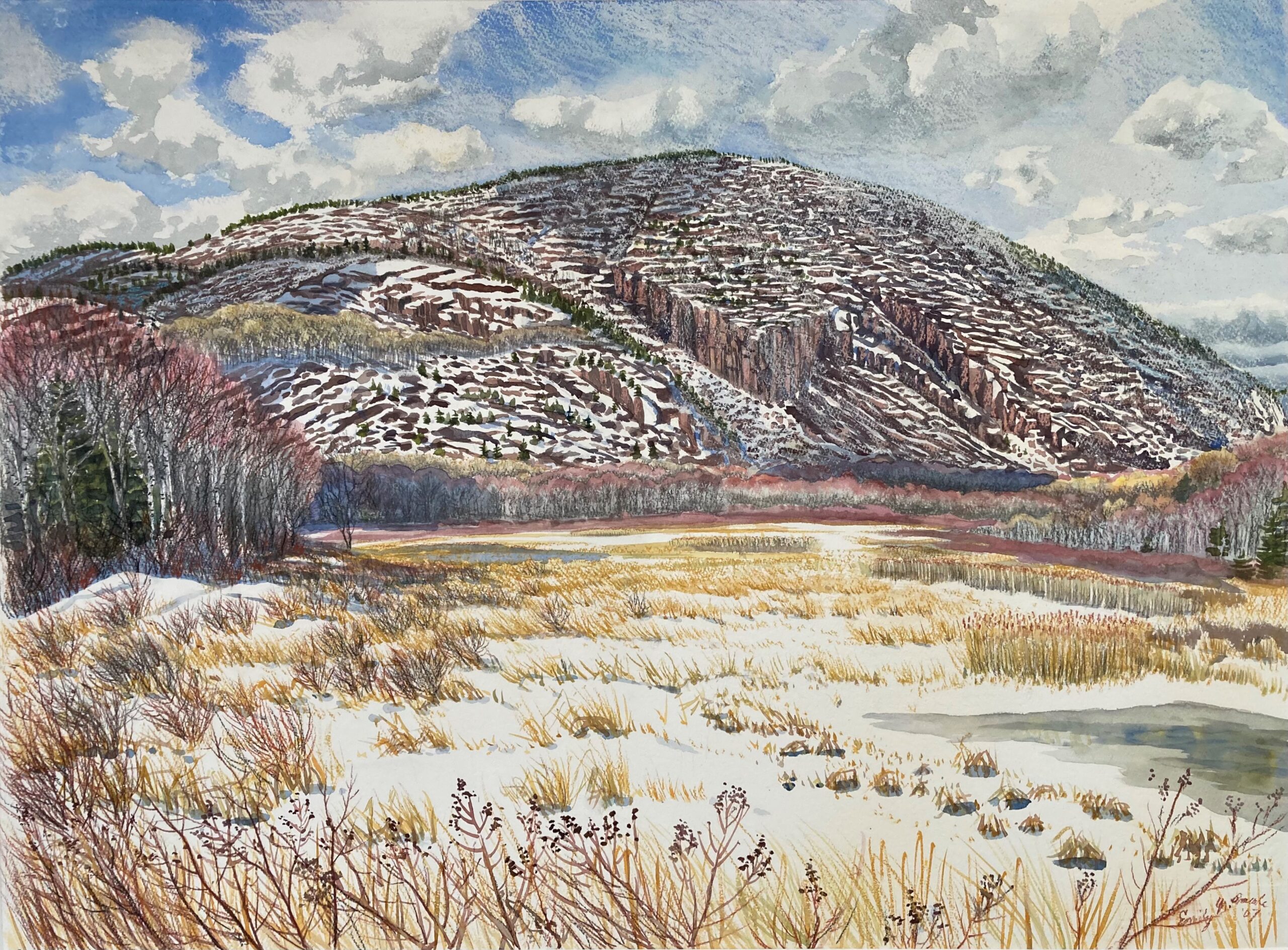Three Artists Share Thoughts on Painting a Snowbound Island
January 24th, 2023
January 24th, 2023
BY CARL LITTLE
“Winter is coming.”
While some of us might whisper that famous dark-and-dire Game of Thrones line to ourselves in, say, mid-October, others take a more positive view of the snow-and-ice time ahead. In fact, to certain artists, Acadia in winter is the “on” season when the park, sans crowds, provides a special beauty—chilly, yes, but glorious.
The work and words of three year-round painter-islanders— Ellen Church of Bass Harbor, Robert Pollien of Town Hill, and Emily Bracale of Bar Harbor—help make the argument for turning to the sketchbook and easel when the snows arrive. These are their stories.

Ellen Church, Up the Frozen Marsh, 2010
Church first visited Acadia on a honeymoon camping trip in 1965. Over the years, she returned to visit family, then houses at for a friend in Bass Harbor for three winters. In 1992 she purchased the property and became a full-time resident of Mount Desert Island.
The winter rapture began when Church painted the western mountains while house-sitting her future home. She relished the quiet solitude and the uninterrupted time to work and loved the way snow transformed well-known landscapes. She could traverse frozen lakes and ponds on cross-country skis to access new views.
Watercolor, Church’s primary medium, is especially suited to snowy motifs. “The bright white of the paper lends itself to winter scenery and helps to define the dark contrasting shapes of the mountains, trees, and shorelines,” she writes. Freezing watercolors keep her from painting outdoors, but she has sketched while standing on skis on the carriage roads or on a frozen marsh.
Church has gravitated to parts of the park in her neck of the island—Wonderland Trail, Ship Harbor, Bass Harbor Marsh. A pitch pine decked out in white, a snow-flecked view of the sea, a frozen marsh zigzagging into the distance: this is the lyric landscape she has found irresistible.

Robert Pollien, Spruces on Great Head, Mount Desert Island, 2014. Courtesy of Dowling Walsh Gallery, Rockland, Maine.
Pollien first beheld Acadia on a 1986 trip to camp on some friends’ land in Sullivan. During his visit, he painted at Schoodic and made a small study on Ocean Drive near Monument Cove. Returning to MDI in 1994 to live year-round, he began in earnest his winter ramblings.
Like Church, Pollien appreciates the quiet: “I can be alone in a landscape that sees millions of annual visitors,” he writes. At the same time, “the cold enforces focus.”
Primarily a plein air painter, Pollien welcomes the “challenging conditions, beautiful light and solitude [that] combine to make winter painting feel very vital, testing one’s commitment to the task.” He notes that the light changes very quickly in winter with the shadow colors “vivid on sunny days.” When there’s snow, he avers, “the fun really starts.”
Great Head is a favorite spot, “an anonymous little bowl” that is somewhat protected from the wind. Pollien will snowshoe there after big storms and set up to paint. “There’s just something about the way the trees sit, something about the geometry of the scene that I respond to,” he explains. In recent years, Pollien has had a new companion, Captain Waffles, an Australian Shepherd dog. “Waffles is a good sport,” the painter reports, “but he has a two-hour time limit when the weather is very cold,” adding, “he isn’t shy about letting me know that he’s had enough.”

Emily Bracale, Late Snowfall, Champlain Mountain, 2007.
Emily Bracale’s introduction to Acadia came on a visit to College of the Atlantic (COA) in the summer of 1984. She returned as a visiting student for winter term 1987, then fully transferred from Amherst to COA later that year.
Bracale wasted no time responding to winter, starting with simple pen-and-ink sketches of the island. Car-less, she explored by foot, spending “a lot of time on the Shore Path and walking from the campus to Bar Island.”
As she explained in a blog post in 2019, Bracale enjoys plein air painting in Acadia from the comfort of her car. “Maybe that’s cheating,” she writes, “but it’s certainly easier to draw and paint when my fingers are not frozen stiff!” She wears fingerless gloves and “may turn on the engine a few times to warm up a bit.”
That’s how Bracale came to paint her late winter view of Champlain with its dusting of snow “outlining every cliff ” on the mountainside. She taped a large piece of watercolor paper to heavy cardboard and leaned it against the dashboard. Seated in the front passenger’s seat, the left-handed painter placed brushes, paints, and a couple of colored pencils on the driver’s side, with empty yogurt container for paint water secure in the cup holder. The painting, she reports, was mostly finished “on site ‘dans l’auto.’”
Bracale and Pollien have both shared their love of painting Acadia through workshops and outings in the park; information about their offerings can be found on their websites. Church supports the Southwest Harbor Library through sales of notecards of her Acadia watercolors. All three artists are devoted to their island community and the wintry world that inspires them.
__________________________________________________________________________________________________________________________________
CARL LITTLE of Somesville recently received the Lifetime Achievement Award for his art writing from the Dorothea and Leo Rabkin Foundation.